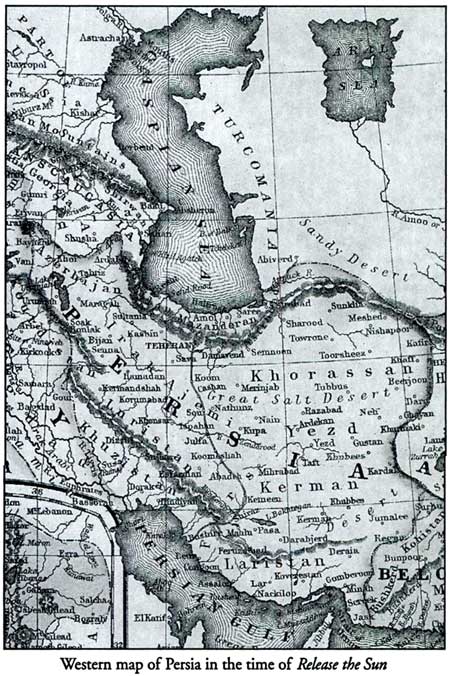
|
|
Abstract: Millennialism gripped many around the world during the early 19th century. While Christians expected the return of Christ, a wave of expectation swept through Islam that the "Lord of the Age" would appear. This is a living history of that period. Notes: Text from Ocean. This version adds formatting. See it also at Google Books. |
Release the Sun
by William Sears
Wilmette, IL: National Spiritual Assembly of the Bahá'ís of the United States, 1960| single page | chapter 1 |  |

click for larger image
[page xiii]
FOREWORD
The following is the first in a series of three books which will tell the stories of the central figures of the Bahá'í Faith. This book, Release the Sun, gives the early history of the Bahá'í Faith up through the hour of the martyrdom of its Herald, the Bab. Professor Edward Granville Browne of Pembroke College, Cambridge University wrote of this period in history, saying: "I am very anxious to get as accurate an account of all the details connected with the [faith of the Bab] as possible, for in my eyes the whole [story] seems one of the most interesting and important events that has occurred since the rise of Christianity --and I feel it my duty, as well as my pleasure, to try as far as in me lies to bring the matter to the notice of my countrymen --for suppose anyone could tell us more about the childhood and early life and appearance of Christ, for instance, how glad we should be to know it. Now it is impossible to find out much -- but in the case of the Bab it is possible -- So let us earn the thanks of posterity, and provide against that day now."[1] This is an attempt to bring just such an account of the life of the Bab to the attention of the world. This same story has been set down in everlasting language for the scholar, in Nabil's Narrative, The Dawn-Breakers, and in God Passes By, written by Shoghi Effendi Rabbani, the Guardian of the Bahá'í Faith. Release the Sun does not present all of the drama of this epic, nor does it give word for word the exciting stories told during these memorable days. It merely offers a simplified version of a story too long neglected and overlooked by man in his search for peace of mind and satisfaction of soul.
[1 The Chosen Highway, Preface. ]
-
William Sears
Wilgespruit, Transvaal,
South Africa September, 1957
PROLOGUE
A small whirlwind of dust moved quietly down the deserted street. It whipped a scrap of paper against a sleeping cat, frightening it out of the doorway into the house. Then all was motionless silence. Suddenly a young child hurried around the corner and raced down the empty street. His bare feet kicked up little puffs from the hot earth. "He's coming!" he cried out. "They're bringing him this way!" People streamed from their houses with the panic of ants whose hill has been struck by a careless foot. The street was alive with thrilled and expectant faces. Their excitement increased as they heard the angry shouts of the approaching mob. A river of men, women and children flowed noisily around the corner. The young man they were following was overwhelmed by their insults. The mob cried out with delight. They knew he would not escape them. He was a captive. His guards pulled him along in front of the crowd by a long rope tied to an iron collar which was fastened about his neck. He was being taken to the authorities so that his death warrant might be signed. When he faltered in his steps, the guards helped him on his feet by jerking savagely on the rope or by planting a well-aimed kick. Occasionally someone would dart out of the crowd, break
[page 2]
through the guards and strike the young man with a fist or a stick. Cheers of pleasure and encouragement accompanied each attacker. When a stone or a piece of refuse hurled from the mob struck the young captive in the face, both the guards and the crowd would burst into laughter.[F1] "Rescue yourself, O great hero!" one of the pursuers called mockingly. "Break asunder your bonds! Produce for us a miracle!" Then he spat in derision at the silent figure. The young man was returned to the barracks square, then a short time later was led to his place of execution. It was high noon in the public square of a sun-baked city. The blistering summer sun flashed from the barrels of the raised muskets. The guns were pointed at the young man's breast. The soldiers awaited the command to fire and take his life. Great crowds were still pouring into the public square. Thousands swarmed along the adjoining rooftops overlooking the scene of death. They were all hungry for one last look at this strange young man who had so troubled their country. He was either good or evil, they were not sure which. He seemed so young to die, barely thirty. Now that the end had come, this victim of all their hatred did not seem dangerous at all. He appeared helpless and gentle, yet confident and handsome. There was a look of contentment, even of eagerness, on his face as he gazed calmly into the hostile barrels of seven hundred and fifty cocked rifles.
| single page | chapter 1 |  |
|
|